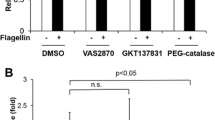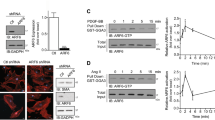Abstract
Apoptosis of smooth muscle cells is a common feature of vascular lesions but its pathophysiological significance is not known. We demonstrate that signals initiated by regulated Fas-associated death domain protein overexpression in rat vascular smooth muscle cells in the carotid artery induce expression of monocyte-chemoattractant protein-1 and interleukin-8, and cause massive immigration of macrophages in vivo. These chemokines, and a specific set of other pro-inflammatory genes, are also upregulated in human vascular smooth muscle cells during Fas-induced apoptosis, in part through a process that requires interleukin-1α activation. Induction of a pro-inflammatory program by apoptotic vascular smooth muscle cells may thus contribute to the pathogenesis of vascular disease.
This is a preview of subscription content, access via your institution
Access options
Subscribe to this journal
Receive 12 print issues and online access
$209.00 per year
only $17.42 per issue
Buy this article
- Purchase on Springer Link
- Instant access to full article PDF
Prices may be subject to local taxes which are calculated during checkout




Similar content being viewed by others
References
Geng, Y.J. & Libby, P. Evidence for apoptosis in advanced human atheroma. Am. J. Pathol. 147, 251– 266 (1995).
Han, D.K. et al. Evidence for apoptosis in human atherogenesis and in a rat vascular injury model. Am. J. Pathol. 147, 267– 277 (1995).
Perlman, H., Maillard, L., Krasinski, K. & Walsh, K. Evidence for the rapid onset of apoptosis in medial smooth muscle cells after balloon injury. Circulation 95, 981– 987 (1997).
Kollum, M. et al. Apoptosis after stent implantation compared with balloon angioplasty in rabbits. Role of macrophages. Arterioscler. Thromb. Vasc. Biol. 17, 2383–2388 ( 1997).
Geng, Y.J., Henderson, L.E., Levesque, E.B., Muszynski, M. & Libby, P. Fas is expressed in human atherosclerotic intima and promotes apoptosis of cytokine-primed human vascular smooth muscle cells. Arterioscler. Thromb. Vasc. Biol. 17, 2200–2228 (1997).
Kockx, M.M. et al. Apoptosis and related proteins in different stages of human atherosclerotic plaques. Circulation 97, 2307–2315 (1998).
Hopkinson-Woolley, J., Hughes, D., Gordon, S. & Martin, P. Macrophage recruitment during limb development and wound healing in the embryonic and foetal mouse . J Cell Sci 107, 1159– 1167 (1994).
Savill, J., Fadok, V., Henson, P. & Haslett, C. Phagocyte recognition of cells undergoing apoptosis. Immunol. Today 14, 131–136 (1993).
Devitt, A. et al. Human CD14 mediates recognition and phagocytosis of apoptotic cells. Nature 392, 505– 509 (1998).
Biancone, L. et al. Development of inflammatory angiogenesis by local stimulation of Fas in vivo. J. Exp. Med. 186, 147– 152 (1997).
Allison, J., Georgiou, H.M., Strasser, A. & Vaux, D.L. Transgenic expression of CD95 ligand on islet beta cells induces a granulocytic infiltration but does not confer immune privilege upon islet allografts . Proc. Natl. Acad. Sci. USA 94, 3943– 3947 (1997).
Seino, K., Kayagaki, N., Okumura, K. & Yagita, H. Antitumor effect of locally produced CD95 ligand. Nature Med. 3, 165–170 (1997).
Miwa, K. et al. Caspase 1-independent IL-1beta release and inflammation induced by the apoptosis inducer Fas ligand. Nature Med. 4, 1287–1292 (1998).
Chinnaiyan, A.M., O'Rouke, K., Tewari, M. & Dixit, V.M. FADD, a new death domain-containing protein, interacts with the death domain of Fas and initiates apoptosis. Cell 81, 505– 512 (1995).
Clowes, M.M. et al. Long-term biological response of injured rat carotid artery seeded with smooth muscle cells expressing retrovirally introduced human genes . J. Clin. Invest. 93, 644– 651 (1994).
Zagorski, J. & DeLarco, J.E. Rat CINC (cytokine-induced neutrophil chemoattractant) is the homolog of the human GRO proteins but is encoded by a single gene. Biochem. Biophys. Res. Commun. 190, 104–110 (1993).
Belvisi, M.G. et al. Induction of cyclo-oxygenase-2 by cytokines in human cultured airway smooth muscle cells: new inflammatory role of this cell type. Br. J. Pharmacol. 120, 910–916 (1997).
Huang, D.C. et al. Activation of Fas by FasL induces apoptosis by a mechanism that cannot be blocked by Bcl-2 or Bcl-x(L). Proc. Natl. Acad. Sci. USA 96, 14871–14876 (1999).
Wu, J.C. & Fritz, L.C. Irreversible caspase inhibitors: tools for studying apoptosis. Methods 17, 320–328 (1999).
Wang, J.M. et al. Expression of monocyte chemotactic protein and interleukin-8 by cytokine-activated human vascular smooth muscle cells. Arterioscler. Thromb. 11, 1166–1174 ( 1991).
Arend, W.P. Interleukin-1 receptor antagonist. Adv. Immunol. 54 , 167–227 (1993).
Ross, R. Atherosclerosis—an inflammatory disease. N. Engl. J. Med. 340, 115–126 ( 1999).
Verheyen, A.K., Vlaminckx, E.M., Lauwers, F.M., Saint-Guillain, M.L. & Borgers, M.J. Identification of macrophages in intimal thickening of rat carotid arteries by cytochemical localization of purine nucleoside phosphorylase. Arteriosclerosis 8, 759–767 ( 1988).
Wisniewski, H.G. et al. TNF/IL-1-inducible protein TSG-6 potentiates plasmin inhibition by inter-alpha-inhibitor and exerts a strong anti-inflammatory effect in vivo. J. Immunol. 156, 1609– 1615 (1996).
Saas, P. et al. CD95 (Fas/Apo-1) as a receptor governing astrocyte apoptotic or inflammatory responses: a key role in brain inflammation? J. Immunol. 162, 2326–2333 (1999).
Abreu-Martin, M.T., Vidrich, A., Lynch, D.H. & Targan, S.R. Divergent induction of apoptosis and IL-8 secretion in HT-29 cells in response to TNF-alpha and ligation of Fas antigen. J. Immunol. 155, 4147–4154 (1995).
Sekine, C. et al. Fas-mediated stimulation induces IL-8 secretion by rheumatoid arthritis synoviocytes independently of CPP32-mediated apoptosis. Biochem. Biophys. Res. Commun. 228, 14– 20 (1996).
Zhang, J., Cado, D., Chen, A., Kabra, N.H. & Winoto, A. Fas-mediated apoptosis and activation-induced T-cell proliferation are defective in mice lacking FADD/Mort1. Nature 392, 296–300 ( 1998).
Yeh, W.C. et al. FADD: essential for embryo development and signaling from some, but not all, inducers of apoptosis. Science 279, 1954–1958 (1998).
Newton, K., Harris, A.W., Bath, M.L., Smith, K.G.C. & Strasser, A. A dominant interfering mutant of FADD/MORT1 enhances deletion of autoreactive thymocytes and inhibits proliferation of mature T lymphocytes. EMBO J. 17, 706– 718 (1998).
Sayers, T.J. et al. Effect of cytokines on polymorphonuclear neutrophil infiltration in the mouse. Prostaglandin- and leukotriene-independent induction of infiltration by IL-1 and tumor necrosis factor. J. Immunol. 141, 1670–1677 (1988).
Nelken, N.A., Coughlin, S.R., Gordon, D. & Wilcox, J.N. Monocyte chemoattractant protein-1 in human atheromatous plaques. J. Clin. Invest. 88, 1121–1127 (1991).
Reckless, J., Rubin, E.M., Verstuyft, J.B., Metcalfe, J.C. & Grainger, D.J. Monocyte chemoattractant protein-1 but not tumor necrosis factor-alpha is correlated with monocyte infiltration in mouse lipid lesions. Circulation 99, 2310–2316 (1999).
Koch, A.E. et al. Enhanced production of the chemotactic cytokines interleukin-8 and monocyte chemoattractant protein-1 in human abdominal aortic aneurysms . Am. J. Pathol. 142, 1423– 1431 (1993).
Gerszten, R.E. et al. MCP-1 and IL-8 trigger firm adhesion of monocytes to vascular endothelium under flow conditions. Nature 398, 718–723 (1999).
Boring, L., Gosling, J., Cleary, M. & Charo, I.F. Decreased lesion formation in CCR2−/− mice reveals a role for chemokines in the initiation of atherosclerosis. Nature 394, 894–897 (1998).
Gu, L. et al. Absence of monocyte chemoattractant protein-1 reduces atherosclerosis in low density lipoprotein receptor-deficient mice. Mol. Cell 2, 275–281 (1998).
Boisvert, W.A., Santiago, R., Curtiss, L.K. & Terkeltaub, R.A. A leukocyte homologue of the IL-8 receptor CXCR-2 mediates the accumulation of macrophages in atherosclerotic lesions of LDL receptor- deficient mice . J. Clin. Invest. 101, 353– 363 (1998).
Shockett, P. et al. A modified tetracycline-regulated system provides autoregulatory, inducible gene expression in cultured cells and transgenic mice. Proc. Natl. Acad. Sci. USA 92, 6522– 6526 (1995).
Kiener, P.A. et al. Differential induction of apoptosis by Fas-Fas ligand interactions in human monocytes and macrophages. J. Exp. Med. 185 , 1511–1516 (1997).
Lie, Y.S. & Petropoulos, C.J. Advances in quantitative PCR technology: 5¢ nuclease assays. Curr Opin Biotechnol 9, 43–48 (1998).
Frevert, C.W., Wong, V.A., Goodman, R.B., Goodwin, R. & Martin, T.R. Rapid fluorescence-based measurement of neutrophil migration in vitro. J. Immunol. Methods 213, 41–52 (1998).
Acknowledgements
The authors thank M. Clowes, H. Lea and E. Mulvihill for instruction and advice. This work was supported by US Public Health Service grants HL03174 and HL62995 and by grants from the Deutsche Forschungsgemeinschaft and F. Hoffmann-La Roche.
Author information
Authors and Affiliations
Corresponding author
Rights and permissions
About this article
Cite this article
Schaub, F., Han, D., Conrad Liles, W. et al. Fas/FADD-mediated activation of a specific program of inflammatory gene expression in vascular smooth muscle cells. Nat Med 6, 790–796 (2000). https://doi.org/10.1038/77521
Received:
Accepted:
Issue Date:
DOI: https://doi.org/10.1038/77521
This article is cited by
-
FADD as a key molecular player in cancer progression
Molecular Medicine (2022)
-
Cytokine regulation of apoptosis-induced apoptosis and apoptosis-induced cell proliferation in vascular smooth muscle cells
Apoptosis (2020)
-
LncRNA HCG18 is critical for vascular smooth muscle cell proliferation and phenotypic switching
Human Cell (2020)
-
EC4, a truncation of soluble N-cadherin, reduces vascular smooth muscle cell apoptosis and markers of atherosclerotic plaque instability
Molecular Therapy - Methods & Clinical Development (2014)
-
BRCA1 gene therapy reduces systemic inflammatory response and multiple organ failure and improves survival in experimental sepsis
Gene Therapy (2013)



